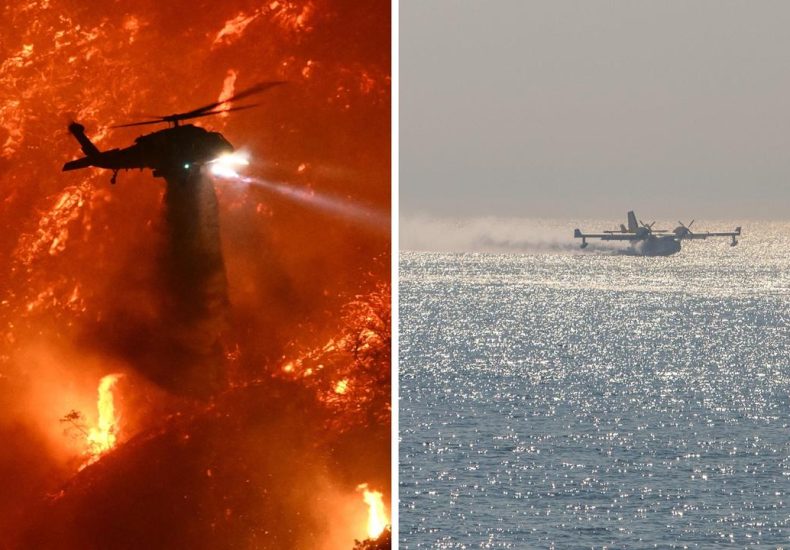
LA Fires Prompt Option for Pacific Seamount Aircraft
Overwhelmed by LA Fires, Pacific Seamount Aircraft Fleet Considered
As Los Angeles faces another devastating wildfire season, authorities are exploring the option of deploying a fleet of 60 Pacific Ocean Seamount aircraft to aid firefighting efforts. These state-of-the-art aircraft, designed for large-scale emergency responses, could provide much-needed relief as traditional firefighting methods struggle to keep pace with the relentless spread of flames.
The Los Angeles fires have overwhelmed local resources, with firefighters working around the clock to protect lives, homes, and critical infrastructure. The introduction of the Pacific Seamount aircraft represents a significant innovation in tackling the growing threat posed by wildfires in California.
The Crisis in Los Angeles
Los Angeles has been battling one of the worst fire seasons in its history. High temperatures, strong winds, and prolonged drought conditions have created a perfect storm for wildfires to spread rapidly across urban and rural areas. Emergency services are stretched thin, with fire crews facing dangerous conditions and limited resources.
The fires have already consumed thousands of acres, forcing mass evacuations and leaving destruction in their wake. As traditional firefighting methods—such as ground crews and smaller water-dropping helicopters—prove insufficient, authorities are turning to advanced technology to gain the upper hand.
What Are Pacific Ocean Seamount Aircraft?
Pacific Ocean Seamount aircraft are a specialized fleet of large, high-capacity firefighting planes designed to combat extreme fire conditions. Equipped with advanced water-carrying systems, these planes can carry and deploy tens of thousands of gallons of water or fire retardant in a single trip.
Key features of the Pacific Seamount aircraft include:
- High Capacity: Each aircraft can carry up to 25,000 gallons of water, significantly more than traditional firefighting helicopters.
- Speed and Range: They can cover vast areas quickly, making them ideal for large-scale fire suppression.
- Precision Deployment: Advanced technology allows for precise targeting of fire lines, reducing wastage and maximizing effectiveness.
These aircraft are also capable of operating in challenging conditions, including high winds and reduced visibility caused by smoke.
Why Now?
The decision to consider the deployment of Pacific Seamount aircraft comes as California faces mounting pressure to find innovative solutions to its wildfire crisis. The state’s traditional resources are often overwhelmed during peak fire season, leaving communities vulnerable to destruction.
Deploying these aircraft could provide a game-changing advantage in firefighting efforts, particularly in hard-to-reach areas where ground crews and smaller aircraft are less effective.
Challenges to Deployment
While the Pacific Seamount aircraft offer promising capabilities, their deployment is not without challenges:
- Cost: The operational costs of these advanced aircraft are significant, requiring substantial investment and coordination between state and federal governments.
- Logistics: Setting up the infrastructure to support these planes, including water supply points and maintenance facilities, can be complex.
- Training: Firefighting crews will require specialized training to integrate the aircraft into existing fire suppression strategies.
Despite these obstacles, experts argue that the benefits far outweigh the costs, especially as the frequency and severity of wildfires continue to increase.
Public and Expert Reactions
The proposal has garnered mixed reactions. Firefighting experts and environmental advocates have largely welcomed the idea, emphasizing the need for advanced solutions to address the growing threat of wildfires.
Residents in fire-prone areas have expressed hope that the deployment of Pacific Seamount aircraft could bring a new level of safety and preparedness to their communities. However, some critics question the financial feasibility and long-term sustainability of relying on such expensive equipment.
What’s Next?
Authorities are currently conducting feasibility studies and pilot programs to evaluate the effectiveness of the Pacific Seamount aircraft in real-world firefighting scenarios. If successful, these planes could become a key component of California’s wildfire response strategy, complementing existing methods and providing a much-needed boost to firefighting capacity.
Conclusion
As Los Angeles battles its latest wildfire crisis, the option to deploy Pacific Seamount aircraft offers a glimmer of hope in an otherwise dire situation. While challenges remain, the potential to revolutionize firefighting efforts and save lives makes this an opportunity worth exploring.
With the wildfire threat showing no signs of abating, the need for innovative solutions has never been more urgent. The Pacific Seamount aircraft could be the game-changer California needs to turn the tide against its ever-growing fire problem.